Turtles with tumours have filled the Turtle Hospital, a specialised hospital in Marathon, Florida Keys, which in 2015 received nearly twice as many sick animals compared to the previous year. Marine experts believe a higher pollution level in sea water is probably the main culprit, or perhaps the population of sea turtles has rebounded, which would result in more individual cases of illness.
Fibropapillomatosis (FP), a disease caused by a herpes virus that makes turtles ill, is characterised by benign epithelial tumours on the surface of biological tissues (tumours grow on the outside). Turtles are believed to become infected with the virus through leeches.
The number of infected juvenile green sea turtles has increased dramatically, says Bette Zirkelbach, manager of the Turtle Hospital.
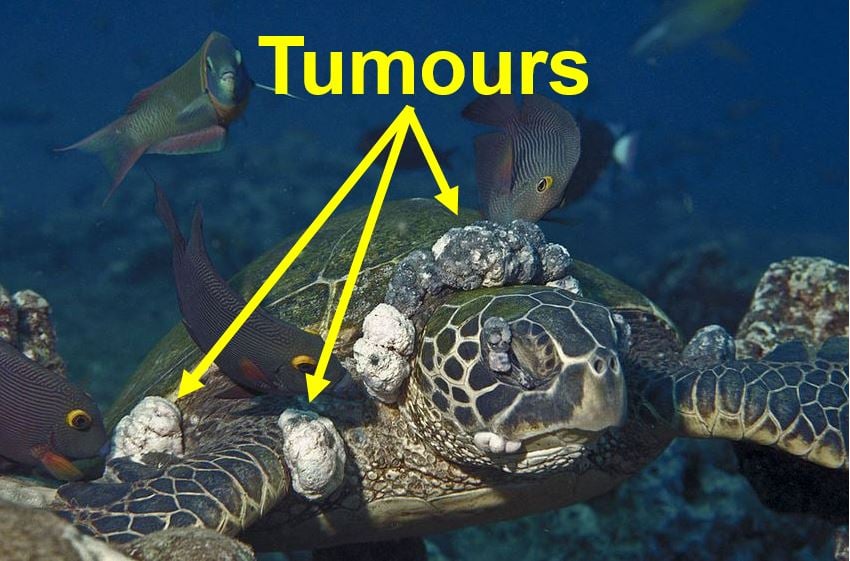 A green turtle with fibropapillomatosis – the fibropapilloma tumours are clearly visible. Some may become so large that the animal is unable to see or use its flippers. This one was filmed off the cost of Hawaii. (Image: Wikipedia)
A green turtle with fibropapillomatosis – the fibropapilloma tumours are clearly visible. Some may become so large that the animal is unable to see or use its flippers. This one was filmed off the cost of Hawaii. (Image: Wikipedia)
Some tumours are huge
Ms. Zirkelbach said last month in an interview with KeysInfoNet:
“Marine turtles with FP have external tumors that may grow so large and hanging as to hamper swimming, vision, feeding and potential escape from predators.”
“Over 50 percent of the green sea turtle population in and around the Florida Keys is infected with FP.”
The Turtle Hospital admitted 172 sea turtles in 2015, compared to 93 in 2014, sixty-eight in 2013, and fifty-six in 2012.
Zoologists believe the increase in cases of sick sea turtles is due to greater pollution in urban areas and farm-water runoff. In order to determine what the cause is, a comprehensive study will need to be done.
Public awareness good for turtles
Ms. Zirkelbach believes greater public awareness regarding sea turtles is also a factor – seventy-five thousand visitors to the hospital last year received educational programs.
The programs encourage people to boat and fish responsibly and to be on the lookout for either injured or sick turtles.
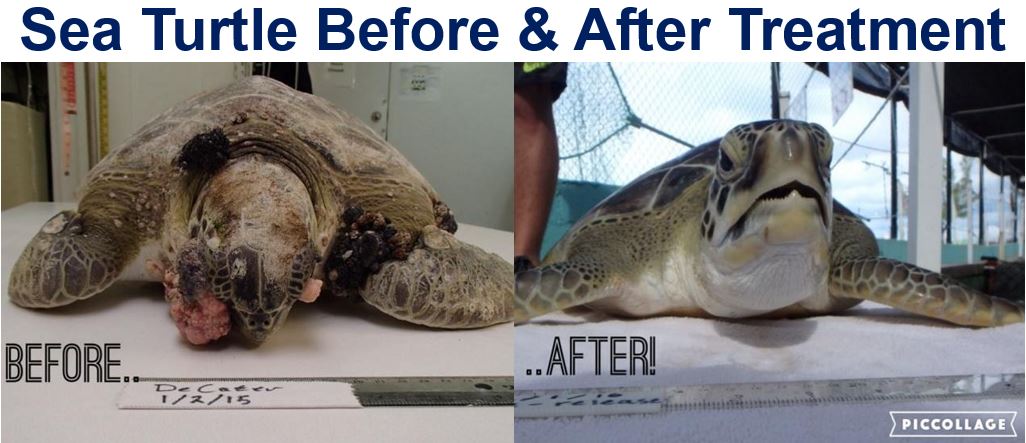 One of the hundreds of turtles treated by the wonderful people who work at the Turtle Hospital. When the animal arrived (left), it was clearly in serious trouble and probably in great pain. After treatment it is ready to go back into the sea and live out its natural life! (Image: The Turtle Hospital Facebook)
One of the hundreds of turtles treated by the wonderful people who work at the Turtle Hospital. When the animal arrived (left), it was clearly in serious trouble and probably in great pain. After treatment it is ready to go back into the sea and live out its natural life! (Image: The Turtle Hospital Facebook)
More than sixty percent of all rescue calls today come from people who have been through the Hospital’s educational program, Ms. Zirkelbach said.
Below are some signs that a sea turtle needs help:
– It is floating on the water’s surface listlessly.
– It is struggling but is unable to dive.
– It is entangled in netting, rope, a fishing line, or plastic.
– There is evidence it may have been damaged/injured from a boat strike.
– It is washed up on the beach and has a skinny appearance.
– The hatchlings (baby turtles) are stuck on the shore.
– Tumours are evident anywhere on its body, especially its eyes and flippers.
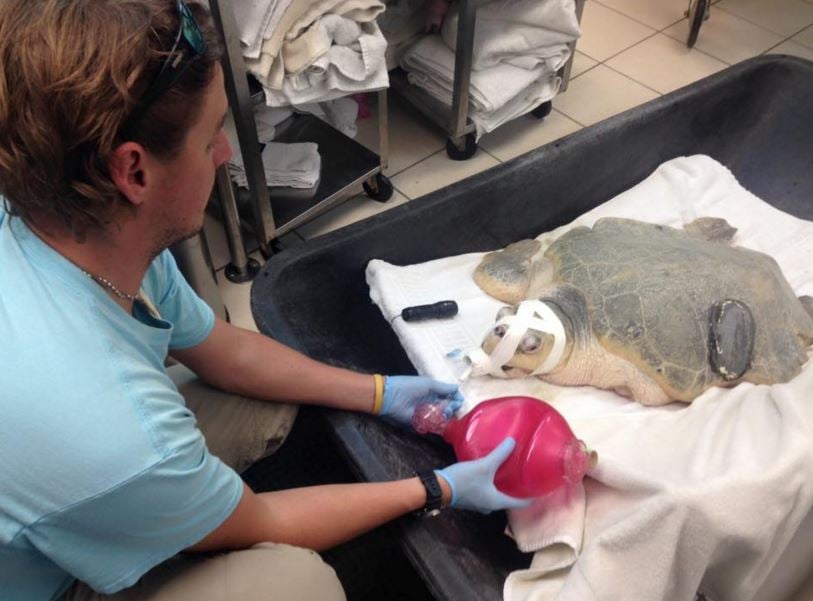 Rehab Specialist Alastair resuscitates ‘Bender’ post surgery. (Image: The Turtle Hospital Facebook)
Rehab Specialist Alastair resuscitates ‘Bender’ post surgery. (Image: The Turtle Hospital Facebook)
Turtle the ‘canary’ of our oceans
Turtle health reflects the state of sea water, experts say. In other words, when there are lots of sick animals, it generally means that the water is not ‘heatlhy’.
When more sick turtles are detected, there is probably more pollution making its way into the sea.
Ms. Zirkelbach said:
“Sea turtles are a canary in the coal mine of sort in our oceans. In the process of saving one of the earth’s most time-honored creatures, we may just be saving ourselves, too.”
Rescuing turtles requires team work
The Turtle Hospital team says often the rescue of a sea turtle requires the help of the Florida Coast Guard or Fish and Wildlife Commission.
The Hospital does not have its own rescue boats, so if a turtle is far from shore, these law-enforcement agencies help get to the animal, and also help in the rescue effort.
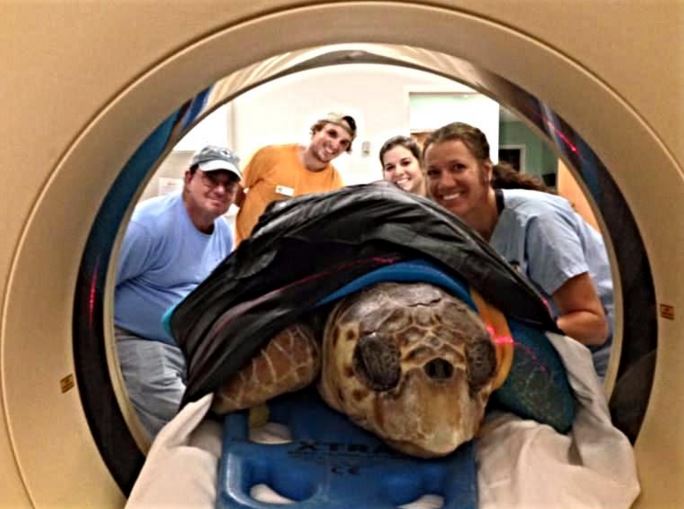 Rescued turtle the staff called ‘Hunter’ took a trip to the local human hospital to have a CT Scan preformed. (Image: Turtle Hospital Newsletter)
Rescued turtle the staff called ‘Hunter’ took a trip to the local human hospital to have a CT Scan preformed. (Image: Turtle Hospital Newsletter)
In its latest Newsletter, the Turtle Hospital wrote:
“Recently, The Coast Guard helped us respond to a Loggerhead Sea Turtle, who was named Laurie, that was found entangled in the rope of a crab trap.”
After rescuing the turtle, the process of rehabilitation starts. Much of the care required by the rescued sea turtles is provided to them by the rehabilitation staff at the hospital. However, veterinarians who work at the Marathon Veterinary Hospital often come in and help.
Even with a state-of-the-art turtle hospital there are still a number of things that cannot be done there. So, sometimes the animals are transported to other centres to get the treatment they need.
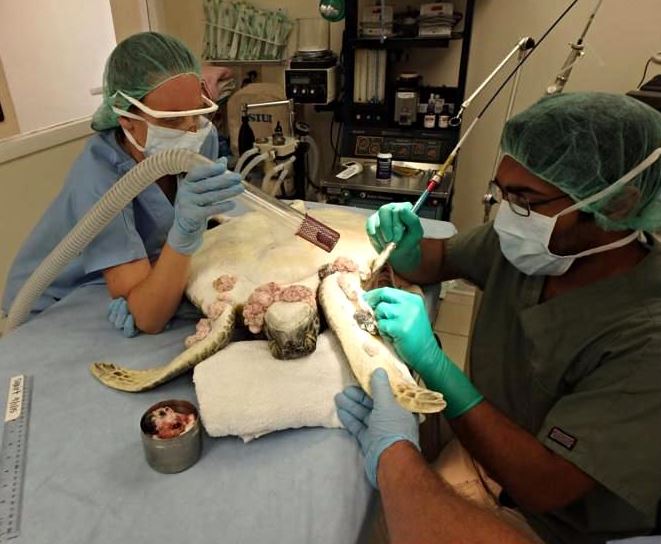 Rehabilitation specialist, Lauren, assisting Dr. Raj from the Marathon Veterinary hospital in the removal of fibropapilloma tumors from a green sea turtle named ‘Squirt’. (Image: The Turtle Hospital Newsletter)
Rehabilitation specialist, Lauren, assisting Dr. Raj from the Marathon Veterinary hospital in the removal of fibropapilloma tumors from a green sea turtle named ‘Squirt’. (Image: The Turtle Hospital Newsletter)
For example, if they have tumors on or around their eyes, they travel to veterinarian ophthalmologist Dr. Karpinski to have them removed.
The last step is to get them back into the sea. The Turtle Hospital wrote, regarding returning the animals to their ocean home:
“Again we find ourselves surrounded by the people of our loving community, gathered in anticipation, cheering and sending well wishes as the sea turtles are released and swim off into the deep blue sea.”
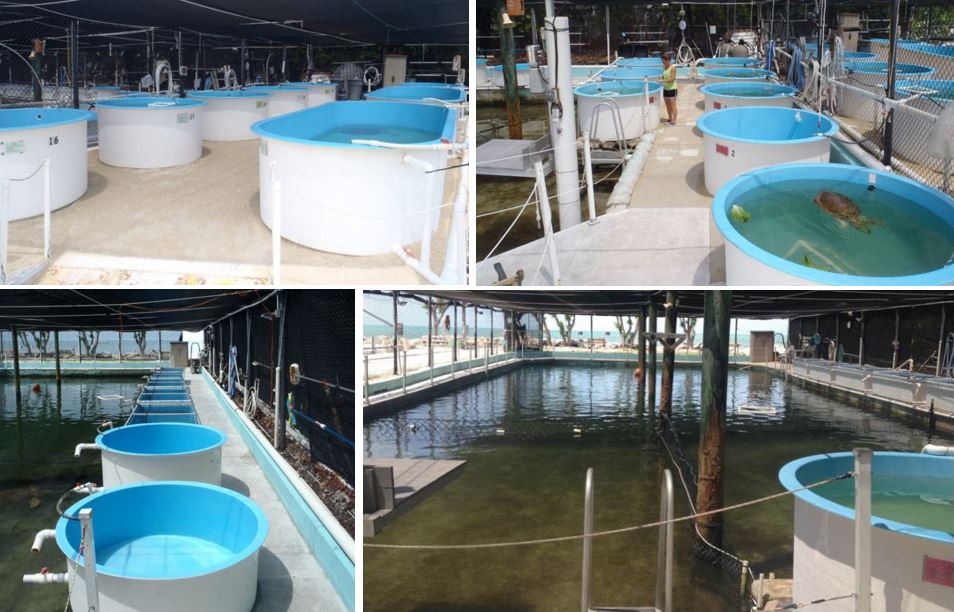 The Turtle Hospital’s Rehabilitation Facility can deal with virtually any type of sea turtle problem, including fibropapilloma tumours, injuries after collisions with boats, entanglement and intestinal blockage. (Image: The Turtle Hospital)
The Turtle Hospital’s Rehabilitation Facility can deal with virtually any type of sea turtle problem, including fibropapilloma tumours, injuries after collisions with boats, entanglement and intestinal blockage. (Image: The Turtle Hospital)
Rehabilitation Facility
The Turtle Hospital has a large Rehabilitation Facility. The chain link enclosure is covered with cloth.
Inside, there are twenty-three individual tanks, ranging in size from 150 to 800 gallons. There is one ultra-large 100,000-gallon salt-water pool.
The enclosure is divided into two sections, each containing individual tanks for the rescued sea turtles that require intensive care.
The top section of the facility is for patients receiving treatment for other non-tumour problems, such as intestinal blockage, boat hits, and entanglement.
Video – Turtle Hospital fills up with sick turtles
This AFP video takes us through a day in the operating room of the Turtle Hospital in Florida Keys, where three patients – Hunter, Bender and Sparty – are being treated.
